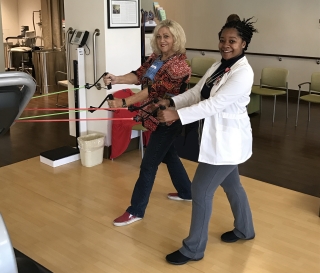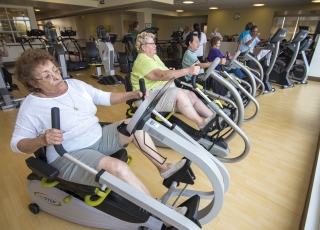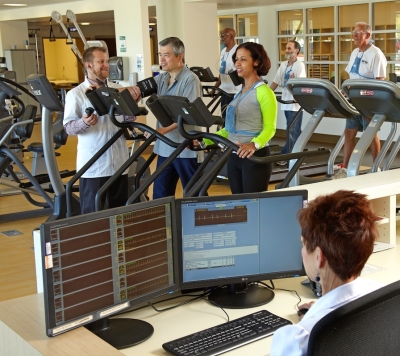
Cardiovascular Rehabilitation
Appointments & Information
- Pomona 909.865.9810
- La Verne 909.392.6531
Studies of heart attack survivors have shown participation in a cardiovascular rehab program can reduce the chances of having a second heart attack within the next year by 17 percent … and by two years after the heart attack, decrease the mortality rate by nearly 50 percent. PVHMC is dedicated not only to improving the quality of life and overall survival of those with coronary diseases, but also to the prevention of heart disease through proactive management of conditions that can lead to cardiac illness.
Inpatient Cardiac Rehab at PVHMC
Cardiac rehabilitation begins while the patient is in the hospital recovering from a heart attack, bypass surgery or other cardiac event. Patients report improvements in their strength, endurance, and independence as physical therapists progress with sitting, walking, and basic arm and leg exercises. This progressive course of activity provides our patients the confidence necessary to achieve success in their Cardiac Home Exercise Program and allows for a comfortable transition to outpatient rehabilitation in the Charles M. Magistro Physical Therapy and Rehabilitation Center. For more information about inpatient cardiac recovery and rehabilitation visit Stead Heart & Vascular Center.
Click the images below for our Cardiac Home Exercise Program Booklet in English and Spanish.
Outpatient Cardiovascular Rehab at PVHMC.jpg)
Nitanth R. Vangala, MD, Medical Director
Upon discharge from the hospital following a cardiac event, the American Heart Association recommends patients begin a comprehensive outpatient rehabilitation program. Prescribed by their physician and provided in a safe and supervised environment, the goal is to improve quality of life by way of exercise, medication management and stress reduction.
Multidisciplinary Team of Experts
For those with coronary artery disease, prescribing a lifestyle change involving regular exercise can be a vital part of treatment. Prior to initiating care, patients are screened for other health issues that could impact their recovery. Our specialized team of clinical exercise physiologists and physical therapy staff includes an APTA board-certified Cardiac and Pulmonary Physical Therapist. These expert clinicians provide a multidisciplinary team approach, offering patients a more comprehensive assessment and evaluation. Working with the patient’s physician, we design an individually tailored exercise plan promoting increased cardiovascular fitness.
Supervised Programs
Cardiovascular Rehabilitation includes several specialized services. Patients are monitored continuously as they slowly move through progressively more challenging exercise protocols.
All exercise sessions are provided in our medically supervised cardiovascular gym equipped with state-of-the-art exercise equipment including treadmills, exercise bikes, weight machines, and resistance machines.
Covered by most insurance plans, enrollment in our programs requires a signed order/prescription from a physician.
Cardiac Rehab Program
- Promotes cardiovascular efficiency
- Speeds recovery
- Improves strength and physical activity tolerance
- Helps prevent prolonged disability
- Reduces re-admissions to the hospital
Common Diagnoses and Procedures Benefitting from Cardiac Rehab:
- Acute myocardial infarction (MI)
- Coronary bypass surgery
- Coronary stenting
- Heart failure
- Heart transplant
- Heart valve repair or replacement
- Percutaneous transluminal coronary angioplasty (PTCA)
- Stable angina pectoris
Cardiac Rehab includes:
- 12-lead electrocardiogram (ECG) and continuous telemetry monitoring
- Blood pressure checks
- Fasting lipid panel, blood glucose and hemoglobin A1c
- 6-minute walk test
- Most insurances cover multiple sessions of supervised exercise, 1–3 days per week
- Risk reduction education
- Monday-Saturday appointments
Click on our video, Cardiac Rehab: The Key to a Heart Healthy Future, to learn more about the program, hear from participants, and see it in action.
“PAD Rehab” (SET) Program
Peripheral Artery Disease (PAD) is a chronic circulatory condition affecting approximately 18 million US citizens, causing leg pain, aching, and cramping when walking. With PAD, plaque build-up in the arteries reduces blood flow to the muscles in the legs. This causes discomfort when walking, a symptom called “claudication.” Leg pain typically worsens the longer you walk and gradually goes away when you rest.
Research has shown patients participating in supervised exercise therapy (SET) were able to improve walking tolerance and distance more than those completing a non-supervised home exercise program, or just walking on their own.
SET programs are supported by the American Heart Association as a first line, noninvasive, low risk therapy for PAD—and the good news is they are covered by Medicare!
Benefits of PAD Rehab:
- Reduces PAD symptoms and leg pain
- Prevents further progression of the disease
- Increases walking tolerance and distance
- Improves muscle strength
- Reduces risk of heart attack or stroke
- Weight loss
PAD Rehab includes:
- Supervised exercise therapy (SET) with guided instruction
- Exercise plan, alternating activity and rest periods
- Treadmill walking
- Resistance training
- Risk factor education
- Most insurances cover multiple sessions of supervised exercise, 1–3 days per week
- Monday-Saturday appointments
Outpatient EECP Program
The Enhanced External Counter Pulsation (EECP) program is available for those who continue experiencing pain associated with angina pectoris in spite of prior treatment.
Benefits of EECP:
- Reduction of angina pain
- Decreased need for medication
- Increased tolerance for exercise and leisure activities
- Improved quality of life
EECP includes:
- Noninvasive procedure carrying little or no risk performed in the Stead Heart& Vascular Center
- External cuffs on legs and buttocks expand and deflate to increase blood and oxygen returning to the heart
- 35 one-hour sessions
- Typically performed 5 days per week (Monday - Friday) for 7 weeks
For more information about the Outpatient EECP Program visit the Stead Heart & Vascular Center.
Post-COVID-19 Recovery Program
- For patients suffering from cardio-pulmonary symptoms related to long-COVID
- A diagnosis of long-COVID is required
- For more information about this program, click here.
Independent Cardiovascular-Pulmonary Wellness Program
What do you do after formal rehab ends?
 Our “Exercise for Life” Program allows participants to extend
the benefits of their rehab program independently, but still exercise
in a medically supervised environment. Structured to assist those in need
of managing heart, vascular, lung, and other chronic conditions, this
program includes:
Our “Exercise for Life” Program allows participants to extend
the benefits of their rehab program independently, but still exercise
in a medically supervised environment. Structured to assist those in need
of managing heart, vascular, lung, and other chronic conditions, this
program includes:
- Cardiac Risk Stratification Assessment
- Monitoring of blood pressure, heart rate and related risk factors as needed
- Education and personal counseling on risk reduction
- Individualized exercise program designed by medically trained exercise physiologists and physical therapists
- Supervised by our Physical Therapy and Rehab staff
- Exercise performed in our Rehabilitation Services gym
- Monday-Saturday appointments are available
Wellness Program Cost Options:
- $30–4 sessions | $300–6 months
- $60–8 sessions | $600–12 months
Wellness Program Enrollment
- Register through PVHMC Rehabilitation Services by calling 909.865.9810.
- Participation requires your physician to sign a consent to participate Wellness Enrollment form. Click here to download the form.
For more information about PVHMC’s Cardiovascular Rehabilitation Programs, click here to download our Cardiovascular & Pulmonary Rehabilitation brochure.
For more information about Pomona Valley Hospital Medical Center's Rehabilitation
Services, please call
909.865.9810. For maps to all of our rehabilitation facilities
click here.
Leading The Way In Rehabilitative Healthcare Since 1954

.jpg)
.jpg)
